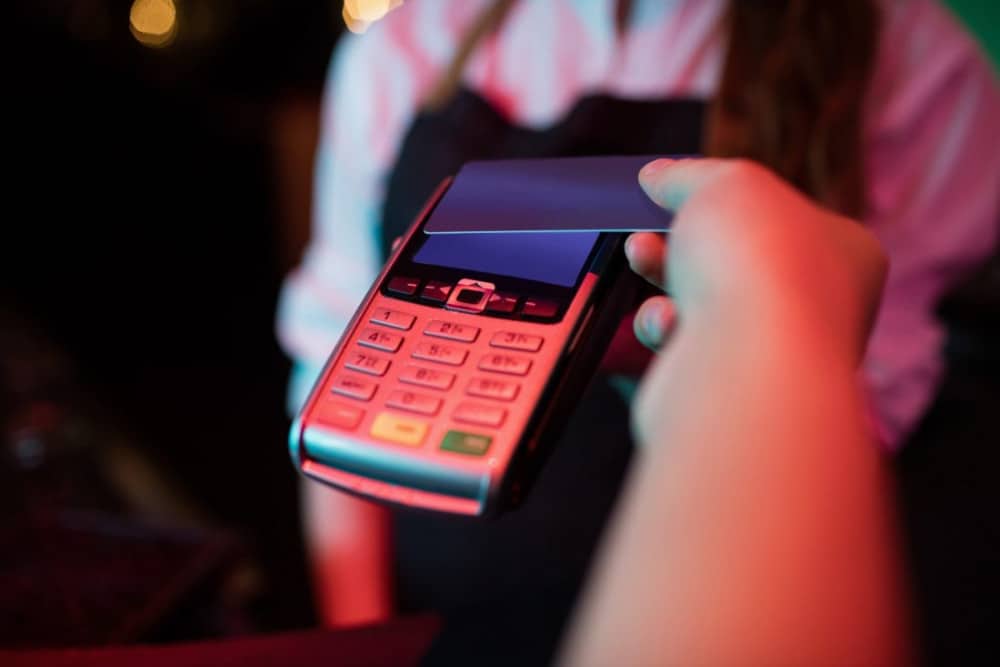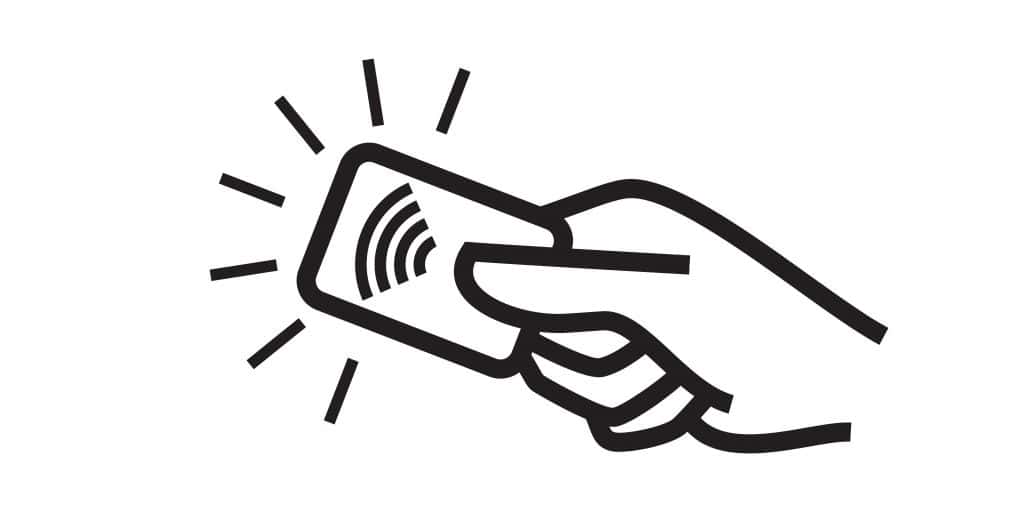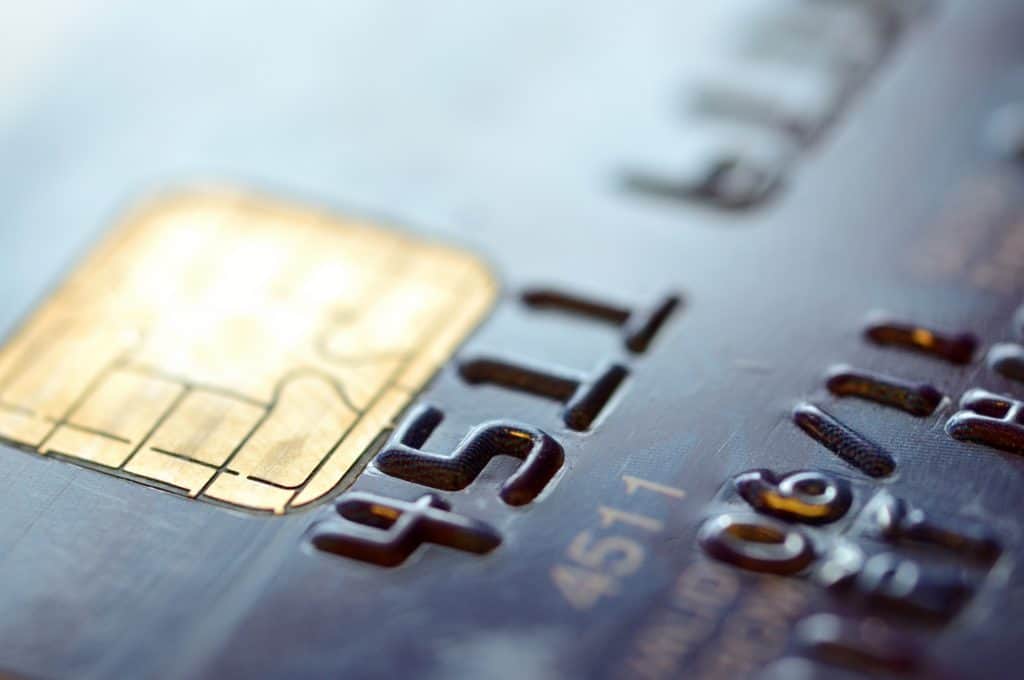So what is RFID Blocking anyway? It seems you can’t search for any wallet these days without seeing it advertised as a “premium” feature.
But what is RFID and why would you want to block it? We’ve got you covered – we’ll explain what it is, what the concerns are, and what you can do about it.

What Is RFID Anyway?
Radio-Frequency Identification, more commonly known as RFID, is a type of technology that has been around since the 1960s, but you might not know much about it. If you have a newer credit card, then you just might have an RFID icon on that card, although these types of cards are much more common outside of the United States.
The symbol looks like a wi-fi icon on its side – and it is typically located on the front side of the card. (Note: not all credit cards with RFID technology will bear this icon. If you’d like to verify whether or not your card is in fact equipped with this technology, simply call the number for customer service located on the back of your card.)

Simply speaking, the RFID technology can be used to store any data – details such as account information, or if it’s on a passport, then details about who you are – and can also be used as a system whereby objects or even living things, such as animals, are tracked. RFID technology is also used with important objects such as credit cards and passports because it quickens the speed with which information is transmitted, such as during transactions.
The object with the technology will feature what’s known as an RFID tag, which can be placed on anything from books to grocery store items and beyond. The data that are thus stored on the RFID tag is then read by the RFID reader. You can think of this as you would a scanner. The information is transmitted with radio signals, hence the shape of the RFID icon.
In this way, objects are both identified and tracked easily through the radio waves. Taken together, the RFID reader and tag make up the collective RFID system. RFID technology has also been used to track livestock and pets, facilitate automatic tolling systems, enable automatic gates, and provide vehicle identification and performance monitoring.
These tags can be “active” (they have their own power) or “passive” (they only transmit in response to a reader sending a signal – this how most credit cards work since they have no battery in them).
RFID and Credit Cards
Since around 2005 in the US, select credit cards have featured the RFID technology that allows for contactless payment. If you’ve ever been asked to simply tap your credit card against the machine when before you would have to swipe or insert it, then you have paid using RFID technology. It has sped up the rate that stores can get customers in and out, and customers like it because it’s convenient.
Unfortunately, some of the advantages of RFID technology are also what make people so wary of it. For instance, the RFID tag does not have to be in the direct line of sight of the RFID reader; it can be concealed and the reader may still be able to scan the RFID tag. With the right technology, identity thieves can in theory access your information and download those personal details just by getting close to you and/or to your wallet.

This has been covered numerous times in the press, for example in this NBC News feature from back in 2011!
Many RFID readers come with an impressive read range on the tags. This, however, is what worries some people who grow wary of criminals wishing to steal their information. If they wanted to, credit card and identity thieves could purchase a reader and would be able to get your data almost instantly. For this reason, many people have pondered whether or not to invest in RFID blocking gadgets.
What is RFID Blocking?
As the technology and the potential to steal information becomes more advanced, so do the protections that various companies offer. Nowadays, you might see wallets, purses, bags, and even articles of clothing that offer RFID protection that “shields” your information and renders it unable to be picked up by unwanted readers. What they are doing is offering versions of their products that come with RFID blocking technology or materials, thereby interrupting the electromagnetic waves so that your data cannot be read by unwanted RFID readers.
When manufactured correctly, the wallets, bags, and other objects where you store your credit card will feature material that effectively encases the card and gets between the RFID tag or chip and the reader that is trying to scan it. Think of the encasing as creating a dead zone; you can think of it like when you are in a below-ground room of a building and your cell phone signal is cut off. RFID blocking wallets function in a similar way, only the signal that is cut off is the electromagnetic technology.
Many of these products which are advertised as RFID blockers, however, are much more expensive than their non-RFID blocking counterparts. As a result, some suggest a simple encasement using aluminum foil around your card or wallet can help to prevent the RFID tag from being scanned and read.
Do You Need RFID Blocking?
Taking all of this into account, the question remains: is the threat of having your cards–even your entire wallet–“skimmed” a real and present danger, or are these videos merely scare tactics? Despite what one expert calls the “doomsday” scenarios of many of these videos, there is little reliable evidence that RFID skimming is a major threat.
In the United States, until the last few years, the majority of credit cards in this country did not even feature the RFID technology. The rollout of these cards however, has been accelerated since concerns over COVID made people more interested in avoiding contact with terminals used by other people.
Some contend that RFID skimming crimes go unreported because supposed victims do not realize their information has been stolen. Yet, as others suggest, it seems hard to believe that credit card companies wouldn’t stand up and take notice if widespread fraud began occurring in a particular locale. This is especially true considering credit card companies, by law, are liable for fraudulent charges made with your card over relatively small amounts.
It’s also worth noting that – of course – the credit card companies are well aware of the risks. The card technology is improving all the time and a scammer would actually have a hard time making a purchase with the data they collected.
Thats because the card doesn’t only send your details when you tap it, it actually sends a special one-time code used to authenticate the specific transaction. To make another transaction work, a scammer would need to know how to generate the next one-time code. Frankly, we think you’re much more at risk of someone stealing the card itself and buying something with a tap!
What this Means For You
If you are planning on traveling outside of the United States then for peace of mind you might want to take the precaution of blocking RFID technology when you are out and about. The precautions you take for your wallet and credit card should be the same you take with your passport when you travel. May we recommend one of these travel wallets?

If you are not planning on traveling extensively, yet feel as though you would like to protect your account information, then you can either invest in the RFID blocking products or try the aluminum foil trick. Keep in mind, as stated, that in the United States, this type of fraud is rare, yet you should do what allows you to shop and travel about comfortably.
Is RFID Blocking REALLY Worth It?
So, is RFID blocking technology worth it? The real answer is, “probably not.” Given that reports of actual skimming thefts are very rare, and that RFID blocking products trade in outsized claims of their protective capabilities, you shouldn’t buy a wallet just because it contains RFID blocking technology.
Now, we’re not saying that purchasing a wallet with RFID protection is a bad thing… it’s not. All we’re saying is: don’t go out of your way (or spend an exorbitant amount of money) to make sure you get RFID protection.
If you’re still worried, and feeling a bit “crafty”, you can always make your own RFID blocker. Simply wrap any concerning card or cards with a few layers of aluminum foil. Aluminum will disrupt the electromagnetic field and disable any threatening scanners.
The sad truth is that there are much easier, familiar, and comparatively low-tech ways for thieves to steal your information, such as telephone scams and ATM skimmers. If you really want to avoid cybercrime, you’re better off checking your credit report often and practicing good password management than you are buying RFID blocking products.
All product names, logos, brands, and trademarks are the property of their respective owners
